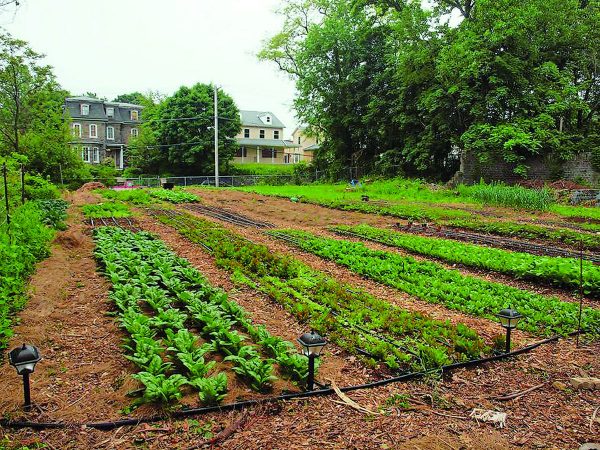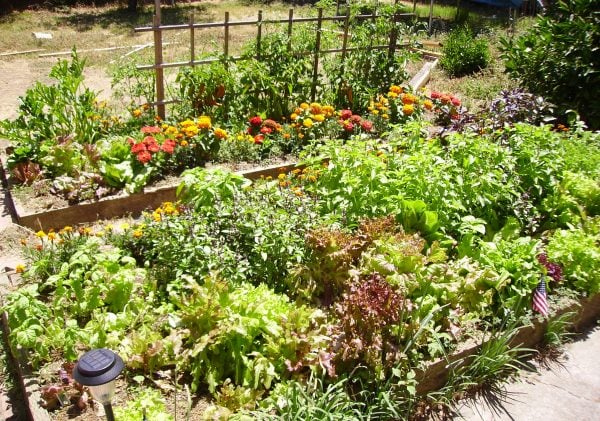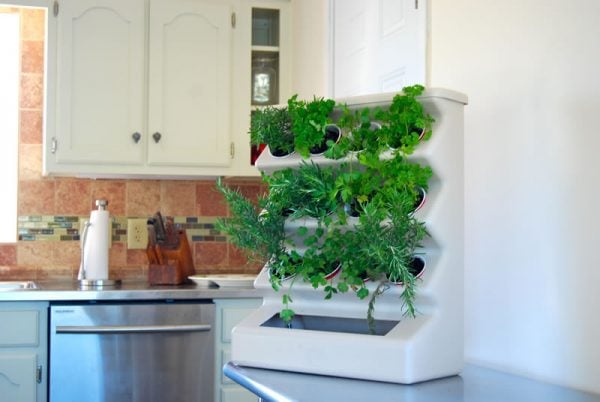Designing the perfect vegetable garden layout isn’t easy. There are so many things to consider! Your vegetables will need a lot of sun, water, nutrients and loving care to grow.
Choosing the right vegetable garden layout is important. Small backyards (or no backyards) will need to be more creative and grow vegetables vertically, hydroponically or in containers. If you’re lucky enough to have a big backyard to play around in, traditional market style of rows and blocks will work best for you.
Some crops won’t grow well in containers (pumpkins will quickly take over your deck!), others don’t like rows (like corn) so I’ve included this for each vegetable garden layout too. Each layout also has its pros and cons. Some layouts make it easy to till the soil, whilst others are better for pest control.
Narrow Rows
Also known as the market gardening method (best manual for this is The Market Gardener book). This vegetable garden layout is the most efficient way to grow a lot of vegetables at once. Crop rotation is easy to manage and the plants are easy to tend because rows are less than 2 feet wide.

Suitable Crops
All vegetables except creepers and grains (corn)
Best layout for labor-intensive crops or continuous harvest plants such as beans and tomatoes
Benefits
- Easy access to tend and harvest crops
- Rows can be tilled in one pass
- Efficient irrigation using drip lines
- Low setup costs
- Looks beautiful
- Good access
Drawbacks
- Higher pests and diseases if multiple rows of the same crop are planted together
- Individual rows usually too narrow for wheelbarrow access (although main access path is wide enough for this)
- Lots of wasted space from access space between each row
Wide Rows and Blocks

A popular alternative method used by home gardeners who want to make the most of smaller plots. Having wider rows of 4 feet means you can grow more crops in the same area that the narrow row method uses – but access to the middle of the row is harder.
Suitable Crops
All vegetables except vines and creepers
Best layout for intensive cropping or continuous harvest plants such as beans and tomatoes. This method is clearly set out in The Intelligent Gardener book.
Benefits
- More efficient for smaller plots
- Space between rows can be wider for wheelbarrow access
- Efficient irrigation using drip lines
- Low setup costs
- Looks beautiful
Drawbacks
- Higher pests and diseases as there is less ventilation around crops
- Middle of row is hard to tend and harvest
- Crops usually planted and harvested all at once
Permaculture
A popular vegetable garden layout for ‘earth gardeners’.
Permaculture vegetable gardens are full of bright flowers, aromatic herbs and beneficial insects.Click To Tweet
Permaculture is often an mix of cottage garden plants and edibles. Plots mostly tend themselves and are usually left to look untidy. If you’re looking for neat rows and picture perfect vegetables this isn’t your garden layout!
A great book for backyard permaculturalists is Gaia’s Garden, which shows you in detail how to make permaculture more productive for small spaces.
Suitable Crops
All vegetables
Benefits
- Low maintenance
- Provides homes for beneficial insects
- Less diseases and pests
- Non-edibles provide a good source of mulch and green manure
- Can look very beautiful (if well planned)
- Low setup costs
- Minimal irrigation
Drawbacks
- Not an efficient method of growing lots of vegetables
- Requires more space than traditional plots
- Vegetables can be hard to tend or harvest (or find!)
- Easily grows out of control and becomes hard to maintain
- Looks messy
Raised Beds
Chances are when I say vegetable garden this is what you think of. Raised garden beds (like these on Amazon) are the most popular vegetable garden layout for backyard gardeners and beginners. The beds bring order and good looks to an otherwise unattractive (but productive) garden. Raised beds are also easier to maintain and crop rotation is super easy to manage once you’ve nicknamed or numbered the beds.

Suitable Crops
All vegetables except tall growers such as corn
Green thumbs
- Easy access to tend and harvest crops
- Garden beds look great
- Creeping crops can flow out of beds and grow on paths for maximum space efficiency
- Easy irrigation setup
- Crop rotation is simple to manage
- Less hard work on your back
- Increased drainage
Brown thumbs
- Expensive to setup
- If made cheaply or quickly the garden beds will fall apart in a few years
- Cannot till soil with powered equipment
- Beds need to be filled with soil which can be expensive and labor intensive
Did you know many berries and fruits thrive when grown in containers? Check out 8 Best Berries to Grow In Containers For Incredible Flavor for more information.
Mounds and Hugelkultur Beds
Hugelkultur is German for ‘mound culture’ and was coined by Sepp Holzer (you can get his incredibly insightful book about growing food sustainably here).

The idea behind mound culture is that you cover a log or other carbon rich materials with soil and then plant the mound. The wood will decompose slowly feeding your plants in the process. A similar method can be done at home using kitchen scraps and yard waste to form small mounds which you then cover with dirt.
Suitable Crops
All vegetables
Green thumbs
- Easy access to tend and harvest crops
- Mounds can be semi-vertical gardens
- Carbon rich waste creates heat as it breaks down which encourages faster vegetable growth
- Free nutrients from the yard waste under the soil
- Soil tends to stay warmer because it is elevated
- Increased drainage
Brown thumbs
- Fresh yard waste may deprive plants of nitrogen for the first few weeks as it breaks down (it will release the nitrogen again later)
- Mounds can become unstable
- Requires a lot of manual labor to set up
- Not ideal for sandy soils or areas of low rainfall
- Soil dries faster as it is more exposed to wind and heat
Aquaponics
Some of you may not know about aquaponics yet – if that’s you then welcome to vegetable gardening in the 21st century! Aquaponics is similar to hydroponics where you grow vegetables in a water and nutrient solution. But instead of using nutrient blends (usually formulated in a lab from chemicals) aquaponics feeds your plants using fish manure.

What’s more interesting though is that the plants filter and clean the water for the fish so it’s win-win. Aquaponics is easier than hydroponics (you just have to remember to feed the fish!) and you get a bonus crop of freshwater fish like trout, silver perch or tilapia.
Aquaponic Gardening gives you a step-by-step guide to building your first aquaponics system and avoiding some of the pitfalls of this high-tech growing method.
Suitable Crops
Best suited to fast growing greens and leafy herbs
Benefits
- Low maintenance
- No weeding or tilling of the soil
- Crops grow 2-3x faster because of all the nutrients and water
- Very water efficient
- Bonus crop of fresh water fish every 6-12 months
Drawbacks
- Expensive to set up
- Can be complicated to build
- May not look that attractive (although I have seen some really nice Aquaponics gardens)
- Nutrient deficiencies may occur because of the ‘closed loop’ system
- Fish may get diseases and also need to be fed daily
- Relies on electronic pumps which can fail and power outages can destroy crops and kill fish
Hydroponics
Very popular for high value commercial crops such as lettuce and tomatoes. Hydroponic vegetable gardens are very productive but have increased costs from electricity, consumables and nutrient fertilisers. But if you don’t have access to soil then it’s a great alternative to growing in containers.

If you’re really strapped for space then get one of these desktop herb gardens for your kitchen. They’re great for growing fresh herbs and fresh salad greens. The best part is – they come with a grow lamp and even remind you to water or feed your crops!
Suitable Crops
All vegetables except corn
Benefits
- Easy setup and plenty of support from local suppliers
- Crops get the exact nutrients they need to grow
- Plants grow 2-3x faster if well managed
- Good use of space especially if grown vertically
Drawbacks
- Ongoing expenses for nutrients, consumables and electricity can be costly
- Nutrient fertilizers are usually crop specific so you can only grow 1 crop at a time unless you have multiple setups
- Hydroponics channels need to be flushed and cleaned regularly to get rid of salt and mineral deposits
Square Foot Gardening
Super popular vegetable garden layout made famous by Mel in his book The Square Foot Gardener. Ideal for small spaces and beginner gardeners. Crop spacing and rotation is all built into the square foot method making this an almost foolproof garden.

Although if you’re planning on a bigger plot you may find the square foot method a little tedious. After all, you’ll be covering a lot of square feet if you’ve got a big patch!
Suitable Crops
All vegetables
Benefits
- Simple to follow planting guides
- Efficient use of space
- Crop spacing is very simple to follow
- Great for maximizing small spaces
Drawbacks
- Requires planting guides or grids which may be hard to find or cumbersome to use
- Time consuming if used in big vegetable gardens
- Establishing new crops and harvesting can be difficult when those square foot areas are hidden in the middle of beds
Keyhole Vegetable Patches
Developed in Zimbabwe for people who were too sick to maintain traditional vegetable plots. The keyhole garden is easily accessible for wheelchairs and those of us who find it hard to reach into garden beds. Every inch of this vegetable garden layout is easily reached making the crops very easy to maintain.

Suitable Crops
All vegetables
Benefits
- Easy access to all crops
- Crop rotation is very simple because crops just move around to the next ‘plot’ on the circle
- Looks good
- Efficient irrigation if using drip or a central sprayer
- Good for small spaces
Drawbacks
- High cost and labor to set up
- Requires a lot of soil to fill the beds (to wheelchair height)
- Taller crops such as corn, may be hard to maintain from a wheelchair
- Not efficient for large areas
Vertical Veggie Growers
Short on space? Then grow up (vertically that is). Vertical gardens are increasingly popular among inner city folks who only have a few meters for a backyard, or even just a porch. Growing vertically is an awesome use of space that would otherwise be wasted.

They are incredibly easy to setup too – especially if you use these felt planting “walls”. If you’re looking for a step-by-step system to growing your crops vertically then check out Vertical Gardening: Growing Up Not Out.
Many plants do very well on a vertical garden, others like corn not so well.
Suitable Crops
All vegetables except corn
Benefits
- Really good for creepers and vines. Also great for greens and herbs.
- Plants can be arranged and used for wall art
- Watering is very efficient
- Great for small spaces
- Setup is quick and easy
Drawbacks
- Usually requires watering by hand daily (or twice daily in hot weather)
- Soil needs to be replaced or fertilized for every time you replant
- Positioning is very important – too much sun and your plants will roast!
- Melons and heavy fruits may need to be supported so they don’t break off from the weight
Indoor Systems
Sometimes there’s just nowhere to grow except inside your home. Windowsills are a great place to grow fresh herbs and salad greens. You can even grow a few tomatoes through the winter and use your home as a hothouse.

These windowsill planters look great and are heavy duty with strong mounting brackets – just don’t expect to grow heavy pumpkins or melons!
Keep in mind that vegetable crops need a lot of sunshine to grow, so be mindful of where you grow your crops. Some gardeners even move their plants to different windows to catch the sun as it moves across the sky.
Suitable Crops
Best for greens and herbs
Benefits
- Low cost and easy to setup
- Super convenient for cooking
- Plants help filter the air inside your home
- Vegetables will be protected from pests and diseases
- Warmer temperatures will help plants grow
Drawbacks
- Soil and water can be messy and even stain your floors
- If plants become diseased or attacked it can be harder to treat
- Soil will dry out quickly from air conditioning and heaters
Vegetable Gardening in Containers
If you’re renting or likely to move then this is for you. You can pack up your vegetable garden and take it to your new home. What I love about container gardeners is that you can move your plants around as they grow.

So if you’ve grown a huge cabbage and it’s now shading out the lettuce, you can just reposition the pots and everyone’s happy again. Plus you can move plants around so they look really nice too, and if one gets sick you just pick him up and quarantine for a few days.
The best containers for vegetable growing are these 10-Gallon Smart Pots. They’re made from breathable fabric which helps aerate the soil increasing the growth of your crops! Your plants won’t overheat either because these Smart Pots allow excess heat to escape (unlike hard plastic or terracotta pots).
Discover the 21 best veggies that thrive in containers here.
Suitable Crops
All vegetables except corn
Benefits
- Super easy to get started – you just need some containers (even milk cartons or buckets will do!)
- Cheap to set up
- Minimal soil required
- Increased drainage
- You can use crop specific soils or fertilisers for each container to get the best growth from your plants
- Move your crops without disturbing their growth
Drawbacks
- Soil in containers tends to dry out quickly, so you’ll need to water more frequently
- Nutrients will leach out of your containers every time you water, so plants may need more fertilizer or slow release fertilizers
- Harvesting crops and replanting can be messy and you’ll probably get dirt all around the container – so be prepared





- Everything You Wanted to Know About Red Tamarillos - June 2, 2025
- A Guide to Tulips: Everything You Need to Know & More… - June 2, 2025
- Guanabana: Description, Flavor, Benefits, And Uses - May 27, 2025
